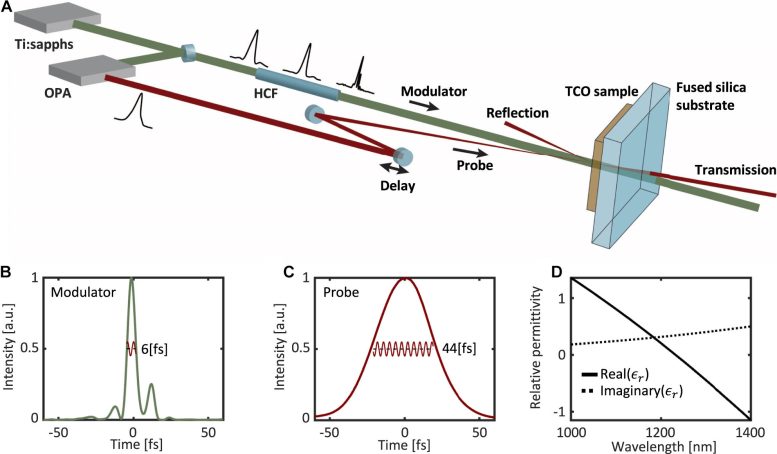A recent study reveals oscillations in the refractive index that are faster than can be explained by current theories.
A study recently published in the journal Nanophotonics reveals that by rapidly modulating the refractive index – which is the ratio of the speed of electromagnetic radiation in a medium compared to its speed in a vacuum – it’s possible to produce photonic time crystals (PTCs) in the near-visible part of the spectrum.
The study’s authors suggest that the ability to sustain PTCs in the optical domain could have profound implications for the science of light, enabling truly disruptive applications in the future.
PTCs, materials in which the refractive index rises and falls rapidly in time, are the temporal equivalent of photonic crystals in which the refractive index oscillates periodically in space causing, for example, the iridescence of precious minerals and insect wings.

Experimental setup for measuring time-refraction in the single-cycle regime. Credit: Eran Lustig et al.
A PTC is only stable if the refractive index can be made to rise and fall in line with a single cycle of electromagnetic waves at the frequency concerned so, unsurprisingly, PTCs have thus far been observed at the lowest-frequency end of the electromagnetic spectrum: with radio waves.
In this new study, lead author Mordechai Segev of the Technion-Israel Institute of Technology, Haifa, Israel, with collaborators Vladimir Shalaev and AlexndraBoltasseva from Purdue University, Indiana, USA, and their teams, sent extremely short (5-6 femtosecond) pulses of laser light at a wavelength of 800 nanometers through transparent conductive oxide materials.
This caused a rapid shift in refractive index that was explored using a probe laser beam at a slightly longer (near infrared) wavelength. The probe beam was rapidly red-shifted (that is, its wavelength increased) and then blue-shifted (wavelength decreased) as the material’s refractive index relaxed back to its normal value.

Transmission spectrograms of 44 fs probe pulses that have passed through the ITO sample, for modulator pulses of different temporal widths. Credit: Eran Lustig et al.
The time taken for each of these refractive index changes was minuscule – less than 10 femtoseconds – and, therefore, within the single cycle necessary to form a stable PTC.
“Electrons excited to high energy in crystals generally need over ten times as long to relax back to their ground states, and many researchers thought that the ultra-fast relaxation we observe here would be impossible,” Segev said. “We don’t yet understand exactly how it happens.”
Co-author Shalaev further suggests that the ability to sustain PTCs in the optical domain, as demonstrated here, will “open a new chapter in the science of light and enable truly disruptive applications”. However, we know as little of what these might be as physicists in the 1960s knew of the possible applications of lasers.
Reference: “Time-refraction optics with single cycle modulation” by Eran Lustig, Ohad Segal, Soham Saha, Eliyahu Bordo, Sarah N. Chowdhury, Yonatan Sharabi, Avner Fleischer, Alexandra Boltasseva, Oren Cohen, Vladimir M. Shalaev and Mordechai Segev, 31 May 2023, Nanophotonics.
DOI: 10.1515/nanoph-2023-0126
The research was funded by the German Research Foundation.
News
Older chemical libraries show promise for fighting resistant strains of COVID-19 virus
SARS‑CoV‑2, the virus that causes COVID-19, continues to mutate, with some newer strains becoming less responsive to current antiviral treatments like Paxlovid. Now, University of California San Diego scientists and an international team of [...]
Lower doses of immunotherapy for skin cancer give better results, study suggests
According to a new study, lower doses of approved immunotherapy for malignant melanoma can give better results against tumors, while reducing side effects. This is reported by researchers at Karolinska Institutet in the Journal of the National [...]
Researchers highlight five pathways through which microplastics can harm the brain
Microplastics could be fueling neurodegenerative diseases like Alzheimer's and Parkinson's, with a new study highlighting five ways microplastics can trigger inflammation and damage in the brain. More than 57 million people live with dementia, [...]
Tiny Metal Nanodots Obliterate Cancer Cells While Largely Sparing Healthy Tissue
Scientists have developed tiny metal-oxide particles that push cancer cells past their stress limits while sparing healthy tissue. An international team led by RMIT University has developed tiny particles called nanodots, crafted from a metallic compound, [...]
Gold Nanoclusters Could Supercharge Quantum Computers
Researchers found that gold “super atoms” can behave like the atoms in top-tier quantum systems—only far easier to scale. These tiny clusters can be customized at the molecular level, offering a powerful, tunable foundation [...]
A single shot of HPV vaccine may be enough to fight cervical cancer, study finds
WASHINGTON -- A single HPV vaccination appears just as effective as two doses at preventing the viral infection that causes cervical cancer, researchers reported Wednesday. HPV, or human papillomavirus, is very common and spread [...]
New technique overcomes technological barrier in 3D brain imaging
Scientists at the Swiss Light Source SLS have succeeded in mapping a piece of brain tissue in 3D at unprecedented resolution using X-rays, non-destructively. The breakthrough overcomes a long-standing technological barrier that had limited [...]
Scientists Uncover Hidden Blood Pattern in Long COVID
Researchers found persistent microclot and NET structures in Long COVID blood that may explain long-lasting symptoms. Researchers examining Long COVID have identified a structural connection between circulating microclots and neutrophil extracellular traps (NETs). The [...]
This Cellular Trick Helps Cancer Spread, but Could Also Stop It
Groups of normal cbiells can sense far into their surroundings, helping explain cancer cell migration. Understanding this ability could lead to new ways to limit tumor spread. The tale of the princess and the [...]
New mRNA therapy targets drug-resistant pneumonia
Bacteria that multiply on surfaces are a major headache in health care when they gain a foothold on, for example, implants or in catheters. Researchers at Chalmers University of Technology in Sweden have found [...]
Current Heart Health Guidelines Are Failing To Catch a Deadly Genetic Killer
New research reveals that standard screening misses most people with a common inherited cholesterol disorder. A Mayo Clinic study reports that current genetic screening guidelines overlook most people who have familial hypercholesterolemia, an inherited disorder that [...]
Scientists Identify the Evolutionary “Purpose” of Consciousness
Summary: Researchers at Ruhr University Bochum explore why consciousness evolved and why different species developed it in distinct ways. By comparing humans with birds, they show that complex awareness may arise through different neural architectures yet [...]
Novel mRNA therapy curbs antibiotic-resistant infections in preclinical lung models
Researchers at the Icahn School of Medicine at Mount Sinai and collaborators have reported early success with a novel mRNA-based therapy designed to combat antibiotic-resistant bacteria. The findings, published in Nature Biotechnology, show that in [...]
New skin-permeable polymer delivers insulin without needles
A breakthrough zwitterionic polymer slips through the skin’s toughest barriers, carrying insulin deep into tissue and normalizing blood sugar, offering patients a painless alternative to daily injections. A recent study published in the journal Nature examines [...]
Multifunctional Nanogels: A Breakthrough in Antibacterial Strategies
Antibiotic resistance is a growing concern - from human health to crop survival. A new study successfully uses nanogels to target and almost entirely inhibit the bacteria P. Aeruginosa. Recently published in Angewandte Chemie, the study [...]
Nanoflowers rejuvenate old and damaged human cells by replacing their mitochondria
Biomedical researchers at Texas A&M University may have discovered a way to stop or even reverse the decline of cellular energy production—a finding that could have revolutionary effects across medicine. Dr. Akhilesh K. Gaharwar [...]





















